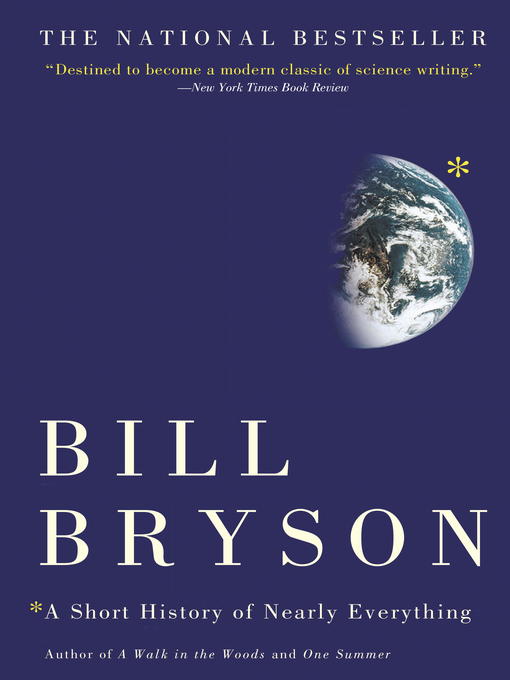-

April 7, 2003
As the title suggests, bestselling author Bryson (In a Sunburned Country) sets out to put his irrepressible stamp on all things under the sun. As he states at the outset, this is a book about life, the universe and everything, from the Big Bang to the ascendancy of Homo sapiens.
"This is a book about how it happened," the author writes. "In particular how we went from there being nothing at all to there being something, and then how a little of that something turned into us, and also what happened in between and since." What follows is a brick of a volume summarizing moments both great and curious in the history of science, covering already well-trod territory in the fields of cosmology, astronomy, paleontology, geology, chemistry, physics and so on. Bryson relies on some of the best material in the history of science to have come out in recent years. This is great for Bryson fans, who can encounter this material in its barest essence with the bonus of having it served up in Bryson's distinctive voice. But readers in the field will already have studied this information more in-depth in the originals and may find themselves questioning the point of a breakneck tour of the sciences that contributes nothing novel. Nevertheless, to read Bryson is to travel with a memoirist gifted with wry observation and keen insight that shed new light on things we mistake for commonplace. To accompany the author as he travels with the likes of Charles Darwin on the Beagle, Albert Einstein or Isaac Newton is a trip worth taking for most readers. First printing 110,000; 11-city author tour.
-

Starred review from May 15, 2003
While this book doesn't cover "nearly everything," it does a fantastic job of tackling certain topics: biology, earth science, chemistry, physics, and astronomy. Writing with wit and charm, Bryson, who has hiked the Appalachian Trail (A Walk in the Woods) and traveled around Australia (In a Sunburned Country), now takes us on a scientific odyssey from the Big Bang to the rise of civilization. Reflecting his gift for making science comprehensible yet fun, he tells the story of the discoveries and the people that have shaped our understanding of the universe. Along the way, we meet some fascinating and eccentric scientists. Although Bryson clearly intends this book for general readers, subject specialists will also enjoy his wry takes. The 30 chapters are divided among seven scientific topics, and this reviewer found himself reading chapters out of order, selecting topics of particular interest. There are useful footnotes, as well as chapter notes and a bibliography. Highly recommended for public and academic libraries. (Index not seen.) [Previewed in Prepub Alert, LJ 1/03.]-James Olson, Northeastern Illinois Univ. Lib, Chicago
Copyright 2003 Library Journal, LLC Used with permission.
-

April 15, 2003
Confessing to an aversion to science dating to his 1950s school days, Bryson here writes for those of like mind, perhaps out of guilt about his lack of literacy on the subject. Bryson reports he has been doing penance by reading popular-science literature published in the past decade or two, and buttonholing a few science authors, such as Richard Fortey (" Trilobite!" " Eyewitness to Evolution," 2000). The authors Bryson talks to are invariably enthusiasts who, despite their eminence, never look on his questions as silly but, rather, view them as welcome indicators of interest and curiosity. Making science less intimidating is Bryson's essential selling point as he explores an atom; a cell; light; the age and fate of the earth; the origin of human beings. Bryson's organization is historical and his prose heavy on humanizing anecdotes about the pioneers of physics, chemistry, geology, biology, evolution and paleontology, or cosmology. To those acquainted with the popular-science writing Bryson has digested, his repackaging is a trip down memory lane, but to his fellow science-phobes, Bryson' s tour has the same eye-opening quality to wonder and amazement as his wildly popular travelogues.(Reprinted with permission of Booklist, copyright 2003, American Library Association.)
-
The New York Times
"Stylish [and] stunningly accurate prose. We learn what the material world is like from the smallest quark to the largest galaxy and at all the levels in between . . . brims with strange and amazing facts . . . destined to become a modern classic of science writing."
-
People
"Bryson has made a career writing hilarious travelogues, and in many ways his latest is more of the same, except that this time Bryson hikes through the world of science."
-
Seattle Times
"Bryson is surprisingly precise, brilliantly eccentric and nicely eloquent . . . a gifted storyteller has dared to retell the world's biggest story."
-
Simon Winchester, The Globe and Mail
"Hefty, highly researched and eminently readable."
-
National Post
"All non-scientists (and probably many specialized scientists, too) can learn a great deal from his lucid and amiable explanations."
-
Ottawa Citizen
"Bryson is a terrific stylist. You can't help but enjoy his writing, for its cheer and buoyancy, and for the frequent demonstration of his peculiar, engaging turn of mind."
-
Winnipeg Free Press
"Wonderfully readable. It is, in the best sense, learned."







